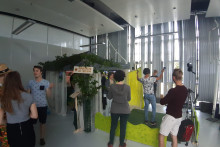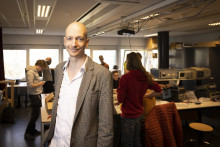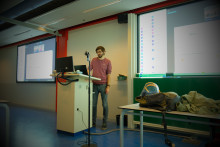Within the course Have fun & Play, the students worked an entire module on building an interactive installation with the intended goal of inviting participants to think about the future and impact of technology. Course teacher Geke Ludden: ‘The installations don’t have to be useful. The most important part is that students learn to provide an experience to the participant.’
One example of this premeditated experience is the machine built by the group called Out of Control. It gives users a sense what it is like to be a nanobot in a blood vessel inside the human body. Dressed up in a doctor’s outfit, Armein Dul (20) takes us through the process of the installation. ‘The user takes place in the machine, once it is closed, the participant can move the nanobot utilizing a controller - represented in videogame format - through the blood vessel. We even included heartbeat sounds so you actually get the feeling of being inside the body. The goal is to create awareness about the positive and potential destructive effects that nanobots can play in our near future and to provide a perspective on the capabilities of nanobots.’
Genetically modified chicken
Near the entrance of the exhibition a group of students are playing a videogame on an arcade machine involving a chicken that has the option to become more genetically modified to overcome obstacles more easily. ‘But not all is what it seems,’ says Ûmmûsûmeyye Artar (19). ‘The player can choose to take the modifications or not, making the game easier but choosing to do so changes the end of the story. Take too many modifications and the game might not end well. The player should take potential negative or positive side effects into account. For example, choosing the skill that allows double jumping makes the game significantly easier, but the chicken also receives the chocolate egg trait every time it double jumps. There are dogs walking around and if they eat the egg they die in horrible fashion. On the other hand, there are also potential positive traits possible, indicating that genetical modification is not only a negative thing.’
Leonardo Chávez Sáenz (19) continues: ‘We had enough experience in our project group to make this project a reality. We have students with backgrounds in art and making videogames. For example, we divided the art and the level designs amongst group members that did not do the coding.’ Bram Rouwhorst (20) adds: ‘When the player reaches the end of the game, they can see an artistic impression of their genetically modified chicken on the projector and they can take a picture with it. The chicken resembles the choices the player made during the game.’
Course teacher Geke Ludden: ‘There are a lot of interesting prototypes presented here. The goal was for the prototypes to fit with the theme of the GOGBOT festival in September and I think that the students did an excellent job in meeting that requirement.’








